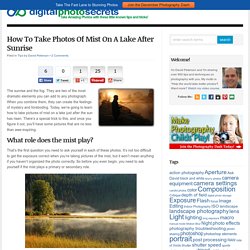

Sunset Photography: Tips to Get Amazing Sunset Photos - PhotoJeepers. Sharing is caring!

Photos taken at sunset capture the soft, diffused light that happens as the sun sets. The Golden Hour light, approximately 30-60 minutes before sunset, is a warm golden glow that produces long, soft shadows. After the sun disappears behind the horizon, the Golden Hour transforms into the Blue Hour. The characteristics of the Blue Hour are a much darker sky and soft blue hues. Sunset photography produces different visual effects in a very short period of time because the quality of light constantly changes.
How To Take Photos Of Mist On A Lake After Sunrise. The sunrise and the fog.

They are two of the most dramatic elements you can add to any photograph. When you combine them, they can create the feelings of mystery and foreboding. Today, we’re going to learn how to take pictures of mist on a lake just after the sun has risen. There’s a special trick to this, and once you figure it out, you’ll have some pictures that are no less than awe-inspiring. What role does the mist play? That’s the first question you need to ask yourself in each of these photos. By getting a little further away from the thick fog, this photographer managed to turn the fog into his main subject.Photo By Flickr User Ian Sane Have a look at the photo above. Photography Equipment - Photography Tips - Photography Technique. Outdoor photography- Photography tips.
Waterfalls. Photographing Skyscapes. Take Your Nature Photography to the Next Level!

You don’t need to travel too far to find an interesting skyscape. Warm days and cold days throw up different light, sunsets and sunrises full of drama. When capturing the sky, catching the light is everything, so patience is important. Armed with a tripod and a wide-angle lens, go outside and take a look! Photographing Seascapes. Wait for the Right Time If you are serious about seascape photography, you need patience.
Always be on the lookout for changes in the weather, colors and moods. Central to seascape photography is natural light and how it affects the scene. Light has three basic qualities-intensity, direction and color, and all of them are affected by the time of the day. Composing your scene at the correct time enables you to get the best shot. Use a Wide-Angle Lens Not every seascape image has to be of crashing waves. Use a Fast Shutter Speed Capturing a wave as it curls creates great drama in a shot. Capture Movement To capture gentle moving water that gives the photo a soft, smooth whitish feel you must use a long shutter speed.
Dramatic Reflections The moment the sun bursts though the clouds, when it’s either setting or rising, creates real drama because the action is mirrored on the water. Use Lines Long exposure times create dramatic skies, which look like cloud trails and smooth, foaming water. The Photographer's Ephemeris: TPE for iOS. The Photographer’s Ephemeris (TPE) helps you plan outdoor photography shoots in natural light, particularly landscape and urban scenes.

It’s a map-centric sun and moon calculator: see how the light will fall on the land, day or night, for any location on earth. TPE is a universal app with optimized user interfaces for both iPad and iPhone/iPod Touch devices. “Get it. This is a quality application that has been very thoughtfully and carefully designed.”★★★★★ 5/5 – BestAppSite.com TPE’s map-based approach means you aren’t limited to a predefined list of locations, which often miss the places many photographers go. Advanced features including visual sun and moon search, automatic time zone and elevation detection, correction for atmospheric refraction and height above the horizon, ensuring that you have the best possible information for planning your shoot. You can even determine when the sun or moon will be visible behind nearby hills and mountains. “It worked perfectly. Key features Map Types. Landscape Telephoto Tips. Black and white landscape photography tips. Black and white landscape photography tips Funnily enough, in the age of digital SLRs and highly colored computer graphics, black and white photography seems to be re-emerging as a strong trend.

Many new photographers presume that all they need to do is take the shot in black and white to start with, using the onboard monochrome camera setting. If only black and white photography was that easy. Like any style of photography, it takes practise. Hyperfocal Distance. If you are shooting landscapes you probably should. Have you ever wondered where to focus on a landscape to render the greatest area of focus from near to infinity? If you know how to figure out your Hyperfocal Distance (HFD), you will know exactly where to focus your lens. So what is HFD?
MCP Photoshop Actions and Tutorials Blog for Photographers. You are here: Blog Home » Guest Bloggers » The 4 Best Types of Natural Light for Your Photography The 4 Best Types of Natural Light for Your Photography I’m very particular about light.

If my shooting conditions aren’t open shade, overcast, or back light,….I don’t shoot. However, as a photographer I’m always trying to learn new things and grow creatively as well as technically. It’s good to get out of your comfort zone at times and try shooting in all kinds of lighting conditions, like high noon, subject facing the sun, and mixed lighting. Here are some of my favorite lighting conditions to shoot in.
OPEN SHADE: Shooting in open shade seems to be the safest lighting situation. OVERCAST: What can I say, I delight in overcast days! BACK LIGHT: Shooting back light is so much fun, yet does not always produce desirable results. AFTER SUNDOWN: Have I mentioned my new favorite time of day to shoot? Photo Tips, Outdoor Photography Tips, Digital Camera tips.